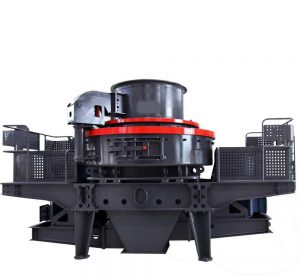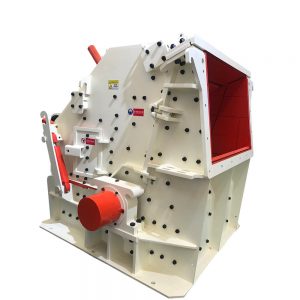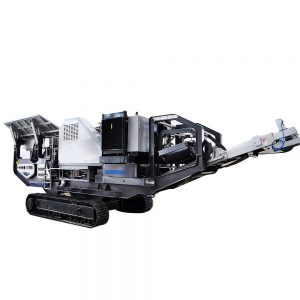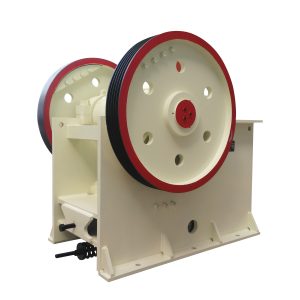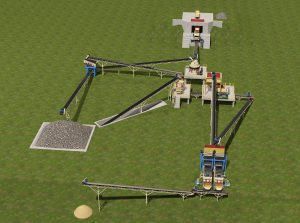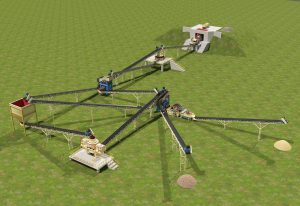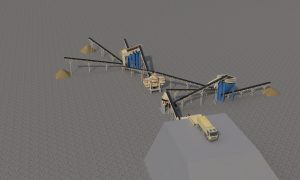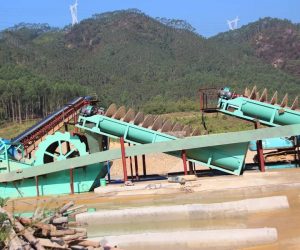What is Blast Furnace Slag and How to Process It?
Blast furnace slag is a solid waste formed by gangue in ore, ash in fuel and nonvolatile components in solvent (generally limestone) in the process of blast furnace ironmaking. It mainly contains oxides of calcium, silicon, aluminum, magnesium and iron and a small amount of sulfide.
What is Blast Furnace Slag?
Blast furnace slag is a kind of industrial solid waste. The slag discharged in the process of blast furnace ironmaking, also known as blast furnace slag, can be divided into steel-making pig iron slag, casting pig iron slag, ferromanganese slag, etc.
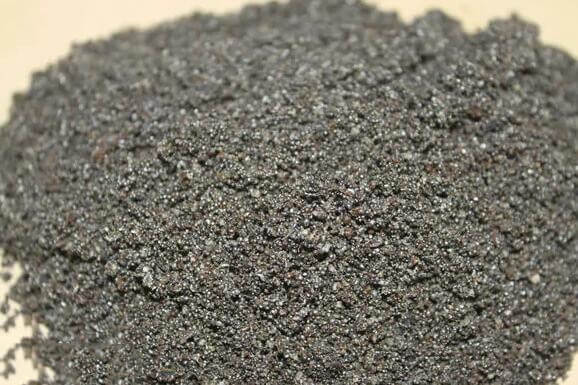
What Industries Are Blast Furnace Slag Used After Grinding?
In China, slag crushed stone can replace natural stone for highway, airport, foundation engineering, railway ballast, concrete aggregate and asphalt pavement. It can be used for: preparing slag crushed stone concrete, applying in soft foundation, paving asphalt pavement with slag crushed stone as base material, which is bright and has good anti-skid performance, good wear resistance, shortening braking distance Used for railway ballast, it can properly absorb the vibration and noise generated when the train is running. The expanded slag ball is a porous lightweight slag formed by cooling the slag with high cooling water. The production methods include spray method, trench method and roller method. It can be used to make lightweight aggregate, inner wall panels, floors, etc. it can also be used in load-bearing structures. Blast furnace slag can also be used to produce slag wool (a white cotton like mineral fiber obtained by melting the slag in the melting furnace and refining it), glass ceramics, silicon calcium slag fertilizer, slag cast stone, hot cast slag, etc.
Classification of Blast Furnace Slag
Air-cooled slag
Also known as hot slag and heavy slag. A partition wall is built in front of the blast furnace from the floor to the furnace platform to form a slag splashing pit. After the slag is discharged from the furnace, it flows into the pit through the slag ditch and is spread into a thin layer with a thickness of about 15 cm. It is cooled by water spray and dug out after solidification. After crushing and screening, it is made into gravel and slag sand to replace natural sand and gravel as concrete, reinforced concrete and prestressed reinforced concrete aggregate below 500, The heat-resistant concrete aggregate with working temperature below 700 ℃ requires wear-resistant and anti-skid paving materials for expressways, racetracks, aircraft runways, railway ballast, pit filling, and foundation cushion filler, sewage treatment medium, etc. This kind of slag gravel is called “all-round engineering aggregate”.
Granulated slag
Also known as water quenched slag and water slag. After the molten slag is quenched with a large amount of water, it can be made into fine-grained water slag dominated by glass. It has potential hydraulic cementitious properties, which can be shown under the action of cement clinker, lime, gypsum and other activators. Therefore, it is a high-quality cement raw material. In China, more than 80% of blast furnace slag is made into granulated slag every year as cement mixing material. About 70% of the cement produced in China is mixed with different amounts of granulated slag. According to the Chinese national standard gb175-77, 15% granulated slag is added to produce ordinary portland cement; Gb1344-77 stipulates that slag Portland cement can be produced by adding 20 ~ 70% granulated slag. Mixing granulated slag can save energy by 20 ~ 40% and reduce cost by 10 ~ 30%. The current water quenching process is to use water with a pressure of 1.5 ~ 2.5 kgf / cm2 and a dosage of 5 ~ 10 times the amount of slag to quench in front of the furnace. Granulated slag can also be used as thermal insulation material, fine aggregate for concrete and road engineering, soil improvement material and so on.
Expansive slag
Each ton of molten slag is treated with about 1 ton of water, which can expand into porous body, and become expanded slag after crushing and screening. It can be used as lightweight aggregate of concrete (volume weight 400 ~ 1200 kg / m3). The production of expansive slag includes pool type method, spray cutting pit method, centrifuge method, flow channel method and turnover chute method. Expanded slag is produced in many countries. Swelling bead, also known as slag ball. In 1953, Canada studied the technology of producing expanded beads. In the production process, a drum with a diameter of 1m, a length of 2M and a speed of about 300 revolutions per minute is installed in front of the furnace to disperse the slag for about 20m. Under the action of the centrifugal force of the drum and the rapid cooling of water and air, the molten slag forms particles with micropores, smooth surface and different sizes (particle size less than 10mm), i.e. expanded beads, with a unit weight of about 1t / m3. Expanded beads are high-quality lightweight aggregate for concrete, which can save 20% of cement than expanded slag; It can also be used as cement mixing materials, road materials, thermal insulation materials, wet grinding or wet grinding slag, as well as materials for stabilizing foundation and improving soil. The particle size of expanded beads is smaller than that of hot Splashed Slag and expanded slag, and it generally does not need to be broken and processed again. The production of expanded beads has the advantages of simple equipment, rapid cooling, fast site turnover, convenient operation and so on. Compared with water quenching slag, the water used for making expanded beads is saved, the amount of steam and hydrogen sulfide discharged is less, the environmental pollution is less, and there is no need for wastewater treatment. Therefore, China, the United States, Canada, France, Britain and other countries pay attention to increasing this process equipment when building or rebuilding blast furnaces.
Slag cotton
The fine slag flow can be sprayed with compressed air or high-pressure steam to produce slag wool, which can be used as thermal insulation, sound absorption and fire prevention materials. Direct injection of blast furnace slag has the advantages of simple process and less investment, but the quality of slag cotton is difficult to guarantee. High quality slag wool can be obtained by taking slag as the main raw material, adding silica, basalt, andesite, sometimes lime and other adjusting components, melting and blowing. Slag cotton is produced in many countries.
In addition, blast furnace slag can also be used as raw materials for cast stone, glass ceramics, fertilizer, enamel, ceramics, etc.
Processing Method
Blast furnace slag can be processed into the following materials by various processes. In China, blast furnace slag is usually processed into water slag, slag gravel, expanded slag and slag beads. Water slag is the process of putting the hot-melt blast furnace slag into water for rapid cooling, which mainly includes slag pool water quenching or furnace front water quenching. Water slag is used as building materials for the production of cement and concrete. Because water slag has potential hydraulic cementitious properties, it can be used as high-quality cement raw materials under the action of cement clinker, lime, gypsum and other activators, and can be made into: slag Portland cement, gypsum slag cement, lime slag cement, slag brick, slag concrete, etc. Slag crushed stone is a kind of crushed stone material obtained by excavating, crushing, magnetic separation and screening of blast furnace slag after natural cooling or drenching cooling of blast furnace slag in the designated slag pit or slag yard. The production processes mainly include hot pouring method and dike method.
How Fine is The Blast Furnace Slag Processed?
The application fineness of blast furnace slag powder is different in different industries. The commonly used processing fineness is 0-325 mesh, 1000 mesh, etc.
What Kind of Mill is Used to Grind 1000 Mesh Blast Furnace Slag Powder?
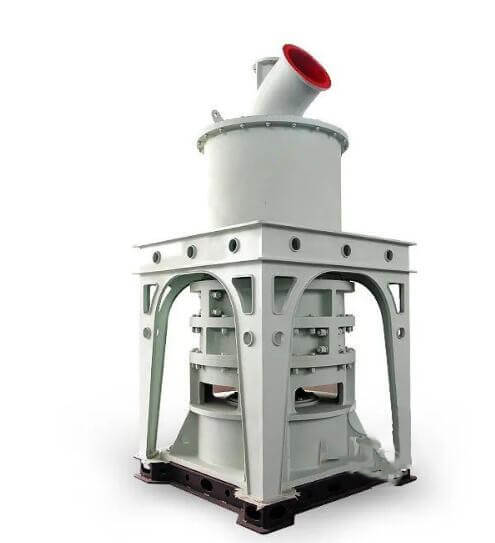
Blast furnace slag powder of 0-325 mesh generally adopts European plate mill. The 1000 mesh blast furnace slag powder is suitable for three ring medium speed micro powder mill.
Three ring medium speed micro grinding is a kind of ultra-fine grinding equipment. Its processing fineness is between 400-3000 mesh, the power consumption is about 22-220kw, and the hourly production can reach more than 50 tons.
The working principle of three ring medium speed micro grinding is to grind the ring layer by layer for many times by using the grinding roller. In addition to processing blast furnace slag, it can also be used for grinding slag, limestone, calcite, feldspar, marble, etc.
Three ring medium speed micro powder grinding tool has the following characteristics:
- Vertical structure is adopted, with small volume, light weight and easy installation.
- Equipped with mature transmission device system, the operation is stable and reliable.
- Good sealing performance and high environmental protection.
- The intelligent detection system is adopted, with high intelligence and automation.
- High screening rate, high production efficiency and uniform particle shape of finished products.
